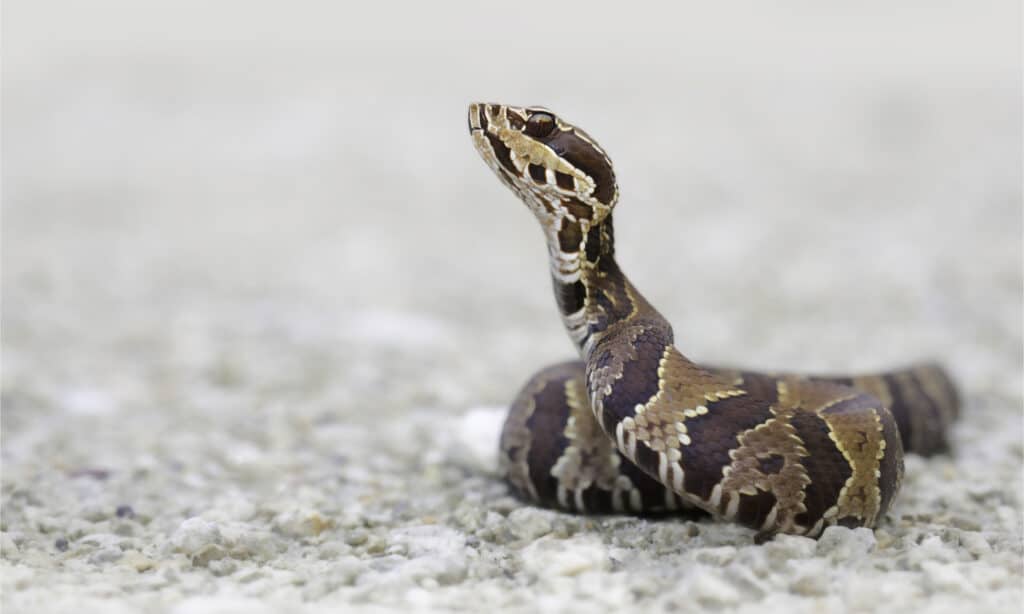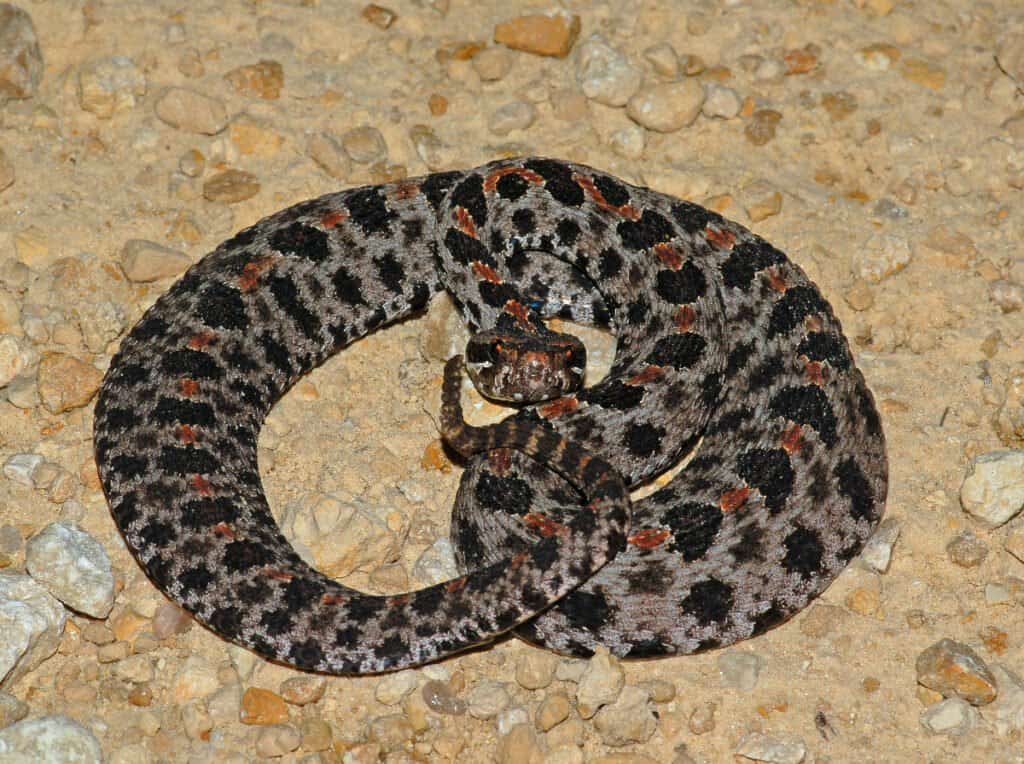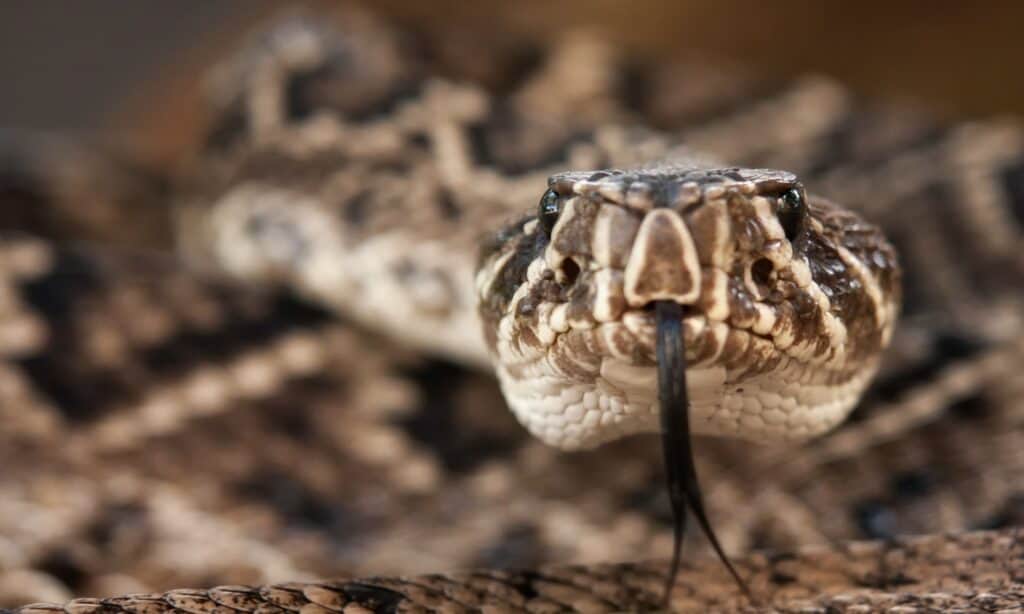The Mississippi River accommodates an outstanding number of animal and plant species. Most of Mississippi’s species are natural inhabitants but some established themselves through invasion. The river is home to a large number of snake species. According to the Mississippi Department of Wildlife, Fisheries, and Parks, over 50 snake species can be found in or near the river. Of this number, only 6 are venomous. Discover what venomous snakes live near the Mississippi.
Where is The Mississippi River Located?

Pegged at 2,340 miles, the Mississippi River starts at Lake Itasca in Minnesota and stretches up to the Gulf of Mexico.
©Milen Mkv/Shutterstock.com
The Mississippi starts at Lake Itasca in Minnesota and stretches up to the Gulf of Mexico. The entire length of the river is officially pegged at 2,340 miles with a total surface area of 1.2 miles. These figures not only make it the third-largest water basin in the world but also the second-longest river in North America.
What Venomous Snakes Live Near The Mississippi River?
Of the Mississippi’s 6 venomous snakes, 5 are pit vipers, and one, an elapid. The six venomous snakes that live near the Mississippi River are cottonmouths, copperhead, timber rattlesnake, pygmy rattlesnake, eastern diamondback rattlesnake, and coral snakes.
Cottonmouths

Cottonmouths are venomous pit vipers that measure approximately 30 to 48 inches in length.
©Kristian Bell/Shutterstock.com
Cottonmouths are venomous pit vipers, popular for standing their ground against aggressors. They are named for their white interior mouths and measure approximately 30 to 48 inches in length. On record, the largest cottonmouth ever recorded measured 74 inches.
Cottonmouths are deadly snakes. Their venom contains hemotoxins that break down blood cells and stop blood from clotting. Research shows that these snakes have a lethal human dose of about 100–150 mg and can kill two humans with a single bite. Although these snakes have a reputation for being aggressive, they aren’t. However, they do not run from attackers.
Copperheads

Copperheads bite more people than any other snake in the entire United States but have a low fatality rate.
©iStock.com/David Kenny
Copperheads bite more people than any other snake in the entire United States. These pit vipers typically measure between 20–37 inches. They are known to be more active during early spring and late fall and typically freeze in their tracks when they are spotted. They do this in an attempt to camouflage and avoid being seen.
Copperheads have an estimated lethal dose of 80 – 100 mg. Because they have an average yield of 26 mg and a maximum yield of 85mg, their bites are rarely fatal. However, what copperheads lack in venom strength, they make up for in bite numbers. Copperheads bite around 2,920 people in the United States every year..
It is important to note that this isn’t entirely the snake’s fault. They freeze in hopes of camouflaging instead of running away when they spot humans. This means that a lot of people accidentally step on them.
Timber Rattlesnake

Timber rattlesnakes, also known as Canebrake rattlesnakes, are endangered ovoviviparous snakes.
©Frode Jacobsen/Shutterstock.com
Timber rattlesnakes are also known as Canebrake rattlesnakes and are easy to identify due to their yellow, tan, or gray rounded heads, and V-shaped tails. In their adult stages, timber rattlesnakes grow to about 36-60 inches and weigh up to 52.3 ounces.
Timber rattlesnakes are an endangered and highly venomous species. They are also slow to reproduce as they do not reach maturity till they are 3 to 4 years old. Even then, these ovoviviparous snakes do not have more than 8 young ones on average. It is illegal to own one in many American states. The venom in their bites contains hemotoxins that affect cells and tissue. This helps timber rattlesnakes digest their prey more easily.
Pygmy Rattlesnake

Measuring 16–24 inches on average, pygmy rattlesnakes are the smallest venomous snakes in the United States.
©Gerald A. DeBoer/Shutterstock.com
Measuring 16–24 inches on average, pygmy rattlesnakes are the smallest venomous snakes in the United States. Despite their short lengths, these snakes have venom that packs quite a punch. Their venom contains hemotoxins that directly attack their victim’s blood cells. In humans, pygmy rattlesnake bites aren’t usually fatal. However, they are extremely painful and can cause the victim to lose the bitten part if the wound isn’t seen by a trained expert.
On the other hand, pygmy rattlesnakes’ venom is suitably effective on the prey they hunt. Pygmy rattlesnakes have keeled scales and dark markings or blotches that run down their backs as well as one or two rows of dark spots along each side of their bodies. Their bellies are colored cream and have dark bars marking them.
Eastern Diamondback Rattlesnake

Eastern diamondback rattlesnakes are deadly pit vipers that grow up to five feet in length.
©iStock.com/Wide-River-Rick
Eastern diamondback rattlesnakes are deadly pit vipers that weigh four to five pounds and grow up to five feet. The species, although not endangered, is drastically reducing in population. Their deadly venom contains hemotoxins that not only attack blood cells but also damage tissue in the affected area. Hemotoxins also lead to circulatory and respiratory problems. They also cause swelling and necrosis, the death of cells in the affected areas.
There is also some evidence of the presence of neurotoxins in their venom. Neurotoxins work by attacking the nervous system and stopping the transmission of signals from the nerves to the muscles. In addition to the damage done, eastern diamondback rattlesnakes typically bite painfully. They are said to have a bite mortality rate of 10 to 30 %. Their colors often range from blackish-gray to muddy gray and even olive green, making it easy for them to camouflage.
Eastern Coral Snakes

Coral snakes are beautiful but deadly elapid snakes.
©Patrick K. Campbell/Shutterstock.com
Eastern coral snakes are beautiful elapid snakes with one of the most dangerous and toxic snake venom known to man. Research shows that their venom is strong enough to kill five humans in a single bite. Their venom contains neurotoxins that cause paralysis and lead to death. Coral snakes measure anywhere from 36 to 60 inches in length and are known as nocturnal recluses.
These snakes have proteroglyphous fangs which enable them to clamp their victims within their strong jaws as they inject venom into them. Since they aren’t pit vipers, they lay eggs as opposed to being ovoviviparous. Female coral snakes can lay up to 3 eggs at a time. These snakes are known to live more than ten years in captivity. However, they aren’t easy snakes to keep. They often go on hunger strikes and even kill themselves by starvation.
What To Do If You Get Bitten By a Venomous Snake In The Mississippi River
If you’re vacationing or working near the Mississippi River, encountering snakes is a possibility that you must be prepared for. If you get bitten by a venomous snake in the Mississippi, here is a list of practical and lifesaving steps to take:
- Get away from the snake
- Contact emergency services immediately
- Do not suck the venom out or cut off the bitten part
- Stay calm as movements can cause the snake’s venom to spread faster
The photo featured at the top of this post is © Sean Pavone/Shutterstock.com
Thank you for reading! Have some feedback for us? Contact the AZ Animals editorial team.






